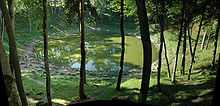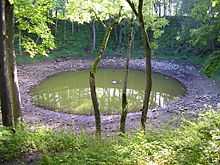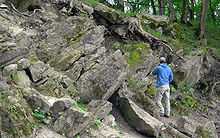Kaali crater



Kaali is a group of 9 meteorite craters in the village of Kaali on the Estonian island of Saaremaa.[1] Formed more than 4,000 years ago (the age of the sediments at the bottom of crater lake), and possibly as long as 7,600 years ago[2] (estimates vary), it is a comparatively recent crater. It was created by an impact event and is possibly the only known major impact event that has occurred in a populated area.
Prior to the 1930s there were several hypothesis about the origin of the crater, including theories involving vulcanism and karst processes. Its meteoritic origins were first conclusively demonstrated by Ivan Reinvald in 1928, 1933 and 1937.
Formation
The impact is thought to have happened in the Holocene period, more than 4,000 years ago. Analysis of silicate spherules in Estonian bogs show that the possible age of the impact craters could be approximately 7,600 years.[1] Other studies show more recent ages, even 7th century BC.[3] The craters were formed by a meteor with an estimated impact velocity of between 10 and 20 km/s with a total mass of between 20 and 80 metric tonnes. The meteorite arrived from the north-east.[4]
At an altitude of 5–10 km, the meteorite broke into pieces and fell to the Earth in fragments, the greatest of which produced a crater with a diameter of 110 m and a depth of 22 m. The explosion removed approximately 81,000 cubic meters of dolomite and other rocks and formed a 7–8 km tall, extremely hot gas flow. Vegetation was incinerated up to 6 km from the impact site.[4]
Kaali Lake (Estonian: Kaali järv) is on the bottom of this crater. Eight smaller craters are also associated with this bombardment. Their diameters range from 12 to 40 meters and their respective depths vary from one to four meters. They are all within one kilometer of the main crater.
Effects
According to the theory of more recent impact, Estonia at the time of impact was in the Nordic Bronze Age and the site was forested with a small human population. The impact energy of about 80 TJ (20 kilotons of TNT) is comparable with that of the Hiroshima bomb blast. It incinerated forests within a 6 km radius.[5]
In mythology
Scholars maintain that the event figured prominently in regional mythology. It was, and still is, considered a sacred lake. There is archaeological evidence that it may well have been a place of ritual sacrifice. At some point during the early Iron Age, the lake was surrounded by a stone wall 470 meters long, with a median width of about 2.5 meters and an average height of 2.0 meters.
Finnish mythology has stories that may originate with the formation of Kaali. One of them is in runes 47, 48 and 49 of the Kalevala epic: Louhi, the evil wizard, steals the Sun and fire from people, causing total darkness. Ukko, the god of the sky, orders a new Sun to be made from a spark. The virgin of the air starts to make a new Sun, but the spark drops from the sky and hits the ground. This spark goes to an "Aluen" or "Kalevan"[6] lake and causes its water to rise. Finnish heroes see the ball of fire falling somewhere "behind the Neva river" (the direction of Estonia from Karelia). The heroes head that direction to seek fire, and they finally gather flames from a forest fire.
According to a theory first proposed by Lennart Meri, it is possible that Saaremaa was the legendary Thule island, first mentioned by ancient Greek geographer Pytheas, whereas the name "Thule" could have been connected to the Finnic word tule ("(of) fire") and the folklore of Estonia, which depicts the birth of the crater lake in Kaali. Kaali was considered the place where "The sun went to rest."[6]

Namesake
The asteroid 4227 Kaali is named after it (there is no connection between this asteroid and the crater).
See also
References
- ↑ 1.0 1.1 "Kaalijärv". Earth Impact Database. University of New Brunswick. Retrieved 2008-12-30.
- ↑ Raukas, Anto; Reet Pirrus; Raivo Rajamae; Reet Tiirmaa (1995). "On the age of the meteorite craters at Kaali (Saaremaa island, Estonia)". Proceedings of the Estonian Academy of Sciences, Geology 44 (3): 177–183.
- ↑ Radiocarbon, Vol. 8, (1966), p. 436.
- ↑ 4.0 4.1 "Kaali Crater". Wondermondo.
- ↑ Siim Veski, Atko Heinsalu, Kalle Kirsimäe, Anneli Poska, Leili Saarse (2001). "Ecological catastrophe in connection with the impact of the Kaali meteorite about 800–400 BC on the island of Saaremaa, Estonia". Meteoritics & Planetary Science 36 (3): 1367–1375. Bibcode:2001M&PS...36.1367V. doi:10.1111/j.1945-5100.2001.tb01830.x.
- ↑ 6.0 6.1 Lennart Meri (1976). Hõbevalge (Silverwhite). Tallinn, Estonia: Eesti Raamat.
- Tiirmaa, R. (1992). "Kaali Craters of Estonia and Their Meteoritic Material". Meteoritics 27 (3): 297. Bibcode:1992Metic..27Q.297T.
- Anto Raukas, J.-M. Punning, T. Moora, Ü. Kestlane, A. Kraut (2005). "The Structure and Age of the Kaali Main Crater, Island of Saaremaa, Estonia". Impact Studies (2): 341–355. doi:10.1007/3-540-27548-7_13.
External links
| Wikimedia Commons has media related to Kaali crater. |
- Kaali crater home page
- About Kaali crater on the official Saaremaa website
- Photos of the Kaali crater
- Impact tectonics
- Interactive panoramic aerial view of the Kaali crater area
Coordinates: 58°22′22″N 22°40′10″E / 58.37278°N 22.66944°E
| Records | ||
|---|---|---|
| Preceded by Henbury |
The last impact event on Earth 660 BC – present |
Succeeded by Incumbent |

